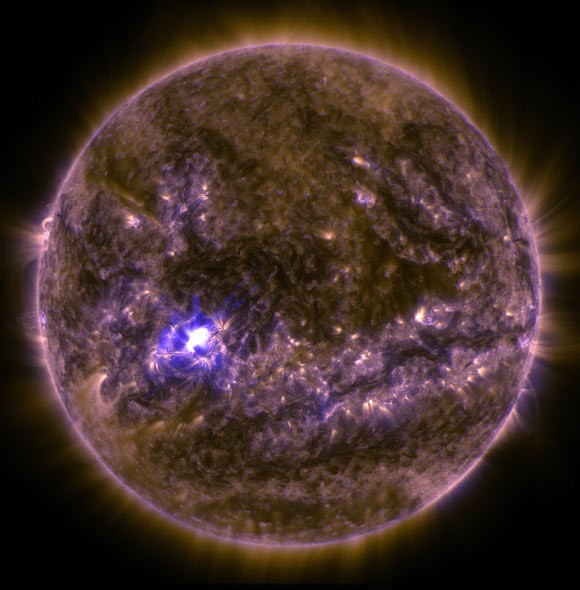Sun Hurls Strongest 'X-Class' Solar Flare at Earth
| Marco Foronda | | Mar 13, 2015 09:45 AM EDT |
(Photo : SDO / NASA) The X2.2-class flare, March 11, 2015.
Our Sun unleashed a massive solar flare aimed directly at our planet on March 11, the first super powerful flare of the year.
The phenomenal eruption, which peaked at 12:22 pm EDT (1622 GMT), was captured on video by NASA's Solar Dynamic Observatory.
Shortly after the huge eruption that measured X2 on the scale of flare energy, Spaceweather.com reported a radio blackout over large swathes of the globe, including much of the Americas.
Like Us on Facebook
"The X-flare scrambled the ionosphere thoroughly so that no decametric radio signals were supported in my part of the world. The ionosphere started to reform after about fifteen minutes when stations began to reappear. (The stuff visible during the blackout was my own observatory electricity. Nothing exterior.)," said amateur radio astronomer Thomas Ashcraft.
The eruption originated from Active Region 12297 (AR12297), a sunspot that fired-off flares of medium-strength over the course of the previous days. The solar flare released Wednesday is categorized as the strongest possible solar flare, a monstrous X-class.
Colorado's U.S. Space Weather Prediction Center (SWPC) commanded by the National Oceanic and Atmospheric Administration said the event caused high-frequency radio communications to falter and created an area-wide blackout that lasted about an hour.
In the course of the past few days and after causing a series of R1 (Minor) and R2 (Moderate) Radio Blackouts, the flare was deemed the largest produced thus far by the sunspot.
Clouds of superheated plasma, known as Coronal Mass Ejections (CMEs), normally accompany a solar flare. This plasma travels at incredible speeds of over a million miles per hour. It takes a fairly long time, about two days or three, to reach the Earth in contrast to radiation that takes just a few minutes.
Power grids and satellite navigation systems may be unsettled by CMEs, especially if the flare is directed at the Earth itself.
The mechanisms behind magnetic reconnection are poorly understood, but on March 12, NASA launched four Magnetospheric Multiscale (MMS) satellites that will orbit Earth in the magnetosphere detecting reconnection events in our planet's magnetic field.
The science gathered from looking at our geomagnetic field will no doubt aid space weather models and will help explain how the extreme magnetic activity in the Sun's corona triggers energetic flaring events.
TagsSun Releases Strong X-Class Solar Flare of 2015, Sun, Solar Flare, X-Class Solar Flare, Active Region 12297, NASA, Magnetospheric Multiscale satellites, Satellites, NOAA, radio blackout
©2015 Chinatopix All rights reserved. Do not reproduce without permission
EDITOR'S PICKS
-

Did the Trump administration just announce plans for a trade war with ‘hostile’ China and Russia?
-

US Senate passes Taiwan travel bill slammed by China
-

As Yan Sihong’s family grieves, here are other Chinese students who went missing abroad. Some have never been found
-

Beijing blasts Western critics who ‘smear China’ with the term sharp power
-

China Envoy Seeks to Defuse Tensions With U.S. as a Trade War Brews
-

Singapore's Deputy PM Provides Bitcoin Vote of Confidence Amid China's Blanket Bans
-

China warns investors over risks in overseas virtual currency trading
-

Chinese government most trustworthy: survey
-

Kashima Antlers On Course For Back-To-Back Titles
MOST POPULAR
LATEST NEWS
Zhou Yongkang: China's Former Security Chief Sentenced to Life in Prison

China's former Chief of the Ministry of Public Security, Zhou Yongkang, has been given a life sentence after he was found guilty of abusing his office, bribery and deliberately ... Full Article
TRENDING STORY

China Pork Prices Expected to Stabilize As The Supplies Recover

Elephone P9000 Smartphone is now on Sale on Amazon India

There's a Big Chance Cliffhangers Won't Still Be Resolved When Grey's Anatomy Season 13 Returns

Supreme Court Ruled on Samsung vs Apple Dispute for Patent Infringement

Microsoft Surface Pro 5 Rumors and Release Date: What is the Latest?










